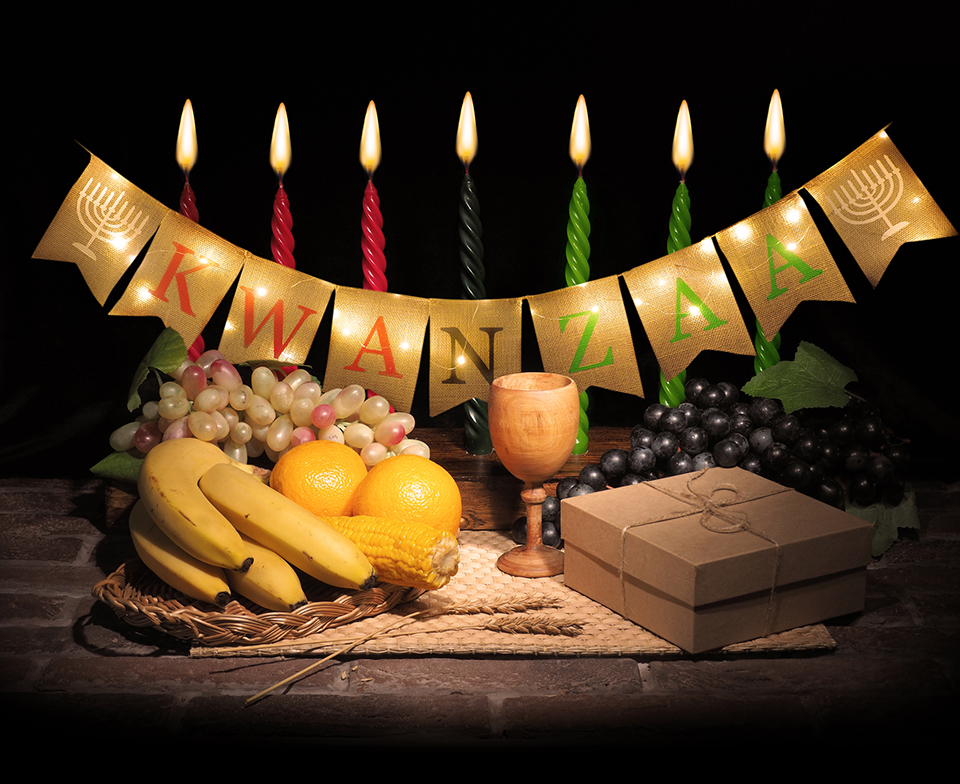Kwanzaa: History and How to Celebrate
Honoring ancestors, life-enhancing community principles, and soul food rooted in African culture– these are at the center of Kwanzaa celebrations that will begin on Dec. 26 and run through Jan. 1, 2024. While not widely known, the history of Kwanzaa has roots in Los Angeles.
Kwanzaa is an African American and Pan-African holiday that originated from “first fruits,” or harvest, celebrations across Africa. The name “Kwanzaa” comes from the Kiswahili phrase “matunda ya kwanza,” meaning “first fruit.”
CSUN film student Gyasi Nettles celebrates Kwanzaa with his family each year and shared why he loves the holiday.
“Kwanzaa is about Black culture specifically, and it’s a celebration of that culture,” he said. “It gives us something to unify around towards the end of the year.”
“It’s rooted in honoring those who came before, centering on the spirit of our ancestors,” said Karin Stanford, professor of Africana Studies and Political Science in the College of Social and Behavioral Sciences. “Kwanzaa celebrates the harvest, so it also celebrates the abundance of the earth and our relationship as stewards of that abundance.”
The cultural holiday was created by members of the US Organization during the turbulent Black Power era in the 1960s when African Americans emphasized self-determination and racial pride. A member’s young daughter questioned why there wasn’t a holiday celebrating Black culture and heritage. After much research, the group created and conducted the first Kwanzaa in 1966 at a home in Baldwin Hills. From there, the holiday spread around the world. Stanford attended Kwanzaa celebrations hosted by the US Organization in her youth.
Stanford explained that there are several reasons why Kwanzaa is popular. “It affirms the Pan-African community, it honors the struggles that Black people have experienced, and it uplifts principles that enhance community,” said Stanford.
Kwanzaa celebrations center around seven principles, one for each day of the holiday. The principles, named with Kiswahili terms, are Umoja (unity), Kujichagulia (self-determination), Ujima (collective work and responsibility), Ujamaa (cooperative economics), Nia (purpose), Kuumba (creativity) and Imani (faith).
The lighting of the kinara, a candleholder, each day is a key part of the holiday. Kinaras hold seven candles, one for each day of celebrations. The candles are red, green, and black, matching the colors of the Pan-African flag.
The sixth day of celebration, the day of Kuumba, typically features a feast, known as Karamu, during which libations are poured to honor the ancestors. Fruit, vegetables and dishes originating from the African continent fill tables and plates. Stanford explained that African American soul food and food common in the Black Diaspora, which include delicacies like okra, rice and peas, jerk chicken, and yams, are staples at the Kwanzaa feast. She also shared that she particularly loves collard greens, sweet potatoes and cornbread.
Nettles said that his extended family and friends come together for the feast. They all enjoy soul food and the lighting of the kinara.
While Kwanzaa was born out of the Black experience, Stanford emphasizes that everyone is welcome to join the celebrations. “In the end, we’re all part of this human race. Despite our different experiences, we should respect and support each other’s commemorations. I think it’s beautiful.”
More information can be found about Kwaanza’s origins at the Tom and Ethel Bradley Center, Black Power Archives at the CSUN Library. The oral history of Kicheko Davis, one of the women involved in creating Kwanza, provides more detail about its origins.


 experience
experience